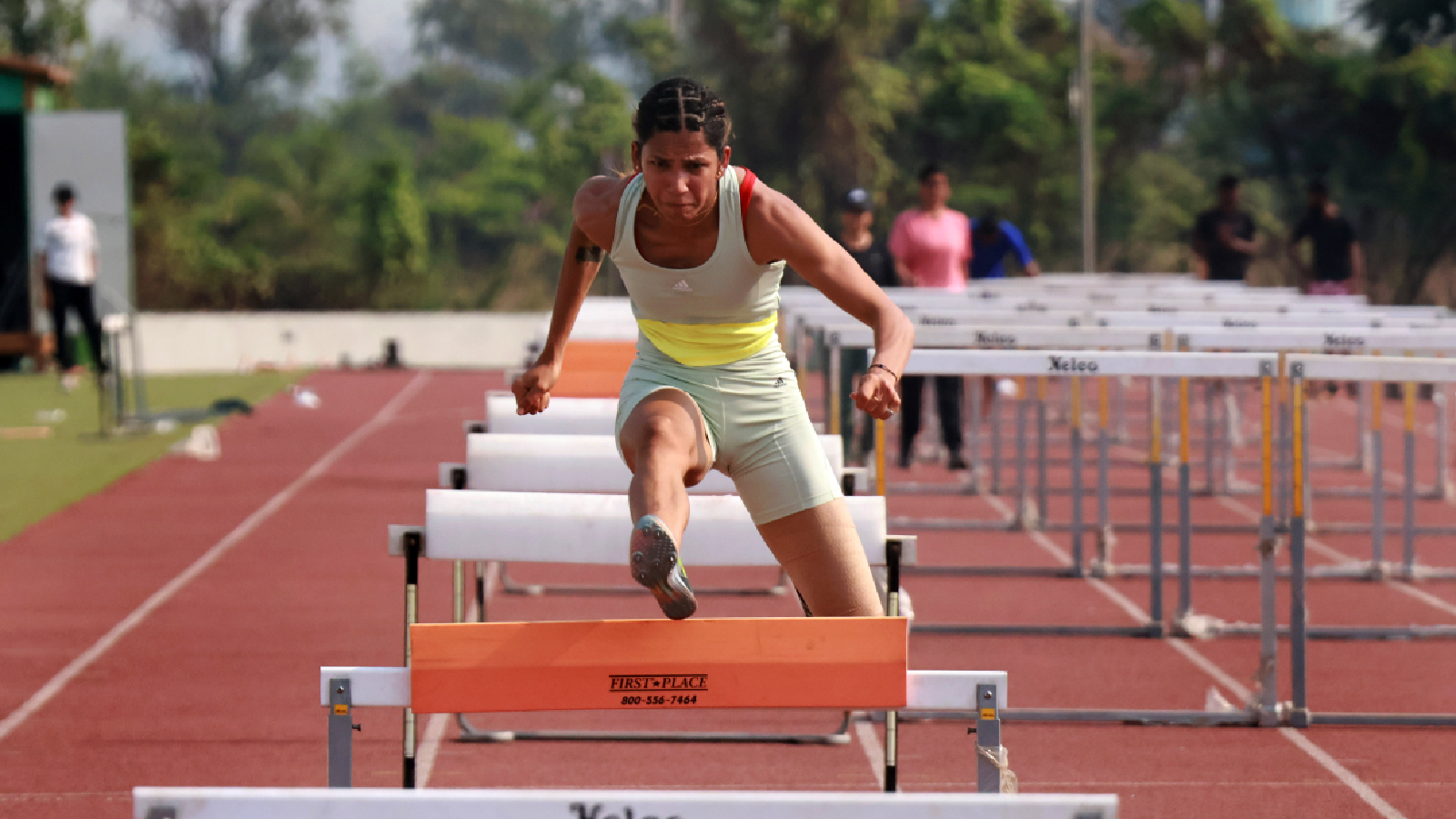A stop clock controls Jyothi Yarraji’s destiny.
Its ticking – on an excruciatingly hot April morning in a quiet corner of Navi Mumbai – is the only constant soundtrack that plays on loop. There are no competitors here – just Jyothi versus the clock.
The first Indian hurdler to qualify for the Olympics in 100m hurdles and her coach James Hillier are driven by a solitary pursuit: shredding microseconds. Or, 0.28 seconds, to be precise.
“Her personal best is 12.78 seconds. I want to get her to 12.5,” Hillier says. “If she runs that in the semifinal, she has a very good chance of making the (Paris Olympics) final.”
Less than three-tenths of a second stand between Jyothi merely being India’s fastest hurdler and getting among the world’s top 8.
It took Hillier three years to cut one second off Jyothi’s personal best time. Cutting milliseconds, he says, could be harder.

He deconstructs a 12.5-second race – staying lower over the hurdles, minimal foot contact with the ground, clocking under 1 second between hurdles and close to 2 seconds from the starting block to the first hurdle.
Jyothi’s quest, however, begins with what on the surface looks like the most subtle of changes. One which, if she nails, could have a profound impact. “From the starting blocks to the first hurdle, we reduced the number of steps I take from 8 to 7,” she says. “Microseconds I can improve.”
Setting up the second hurdle
Since the sprint hurdlers are usually ‘short’, Hillier says, they are quick off the blocks and ‘normally do eight strides into the first hurdle’. That’s how Jyothi ran, too. “(But) I am looking at her and thinking, she’s looking uncomfortable with eight strides,” he says.
Making her take one stride fewer isn’t directly meant to bring down the timing. The purpose, Hillier says, is to make Jyothi set up for the second hurdle better.
“Because she has long legs, when she does eight steps, she’s having to brake a little bit coming into the first hurdle. (Imagine) An airplane taking off. It’ll take off like this (makes an upward gesture with his hand), then go like this (gestures downwards, as if braking) and then back up again. So it’s not smooth acceleration.”
Rewiring the brain
Reducing the number of steps doesn’t happen just like that. Earlier, when Jyothi had eight steps running off the blocks, her right leg used to be forward when she was on the blocks as she took off with the left. Now, it’s reversed.
”I had been competing and training like this for 10 years. Imagine, you are doing everything with your right hand and suddenly you shift to the left. You can’t because our body and mind are coordinated like that,” Jyothi, backed by Reliance Foundation, says. When The Indian Express spent a day with Jyothi at training on April 19, it was only her second week trying this style. A few days earlier, there were doubts. “I told coach it’s not working, I’ll give it up,” Jyothi says. “’He said, ‘You are going good, the second hurdle is very fast, so let’s continue’. I also feel the difference now.”

Hillier adds: “It’s a huge change. In the gym now, every time we do a single-leg exercise, she starts on the right leg first. Rewire the brain so that the right leg is the dominant one, not the left.”
In essence, Jyothi has lost a step. That, in turn, propels her to push harder to accelerate through the first hurdle. Earlier, when she ran with eight steps, she had to apply brakes due to her long strides as she got closer to the hurdle.
“Now, she has to accelerate and that ensures she’s got more momentum off the first hurdle. Then the second is significantly faster. She feels it. And I see it,” Hillier says. “It’s definitely helping. Whether that translates into a faster time, we don’t know.”
Time progression
Back in April, it had been only a few weeks since Jyothi had recovered from a hamstring injury. But she’s going all-out to make up for lost time. On that day, Jyothi had four runs with 12 hurdles in a race – two more than usual to make practice conditions tougher.
Her timings in the first three were the same – 13.8 seconds. But the coach notices her breathing heavily by the time the third run is over. He walks up to her for a brief chat.
“I want you to focus on technique, technique, technique…” he tells Jyothi. “…and one more thing…”
“What, coach?
“Technique!” Both laugh.
Hillier explains: “When she goes to competitions, it is a whole ordeal mentally and physically. You’re probably not sleeping well at night… so invariably when you get to the final, you are tired physically and mentally. So those conditioning must be taught in training. Run technically when tired.”
When she is the most fatigued, Jyothi runs her fastest: 13.6 seconds, two-tenths faster than her first run, when she was fresh. On June 30, at the Inter-State Championships, her timing dropped further, as she finished first clocking 13.06 seconds.

Rhythmic units
Hillier, however, isn’t obsessed by the big number. He breaks down a race into smaller parts.
He wants her to clock close to two seconds from the block to the first hurdle. “But it’s not just about the time, it’s about how you’re setting it up as well,” Hillier says. “You could run a fast time to the first hurdle, but if you are using too much energy doing it, it might affect you at the end of the race. At the start, it’s not necessarily about getting quicker, it’s about setting the second hurdle better and then maybe it’s about getting quicker.”
Once Jyothi sets up the second hurdle, Hillier’s focus shifts to the rhythmic units – the time between two hurdles.
“If she’s going from hurdle 2 to 3 (and so on) under 1 second, we know she’s in 12.5 shape. Now, she might be running at 1.03, something like that. So we need to create an environment where her rhythmic unit is under 1 second.”
Use of foam pads, lower hurdles
So, the hurdles used are a little lower and on top of them rest foam pads. As Jyothi runs, one can hear her clip the pads with her leading leg. “That’s because I want her to be low over the hurdle so we get the time. If I asked her to start hitting the hurdle (without pads), she’s going to have a problem because if she hits it hard, there’s going to be an issue,” Hillier says.
The cushion allows Jyothi to attack the hurdles aggressively, stay low and get used to running a rhythm that’s under 1 second between hurdles, conditioning her body to faster runs.
“It’s like millions and millions of minute steps all the time. Then you put it all together and hope she’s good enough physically, mentally; hopefully, I am good enough as a coach to prepare her to peak at the right time when she goes into the Olympics,” Hillier says. “I can’t promise you she’ll do it. But she’s capable of it.”
I’m Manas Ranjan Sahoo: Founder of “Webtirety Software”. I’m a Full-time Software Professional and an aspiring entrepreneur, dedicated to growing this platform as large as possible. I love to Write Blogs on Software, Mobile applications, Web Technology, eCommerce, SEO, and about My experience with Life.






